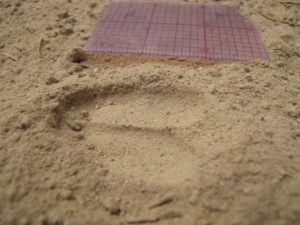Who?

How can you tell?
This area of tracking likely needs little illustration work because identifying an animal’s species from tracks is about static characteristics, and learning to identify tracks makes determining species from them almost a self-actualizing process. The layers help: gaits … location … timing … activity … season …
Though tracks can certainly be used to identify species, sometimes there are are instances when it’s hard to decide exactly who that animal was, for example domestic canine tracks. Tracking is a mental environment where uncertainty can nurture itself, thinning self-confidence and slowing down the process of reading the story. So any thing that can help shift confusion into confidence can be helpful.
The clips below are testing ideas for illustrations that, with a lot of improvements, might help clear away confusion.
————– ————— ————— ————— ————— ————— ————– ————— ————– ————— ————— ————— ————— ————— ————– —————

Concept Illustrated: Species identified: the front track of a White-tailed Deer (Family: Cervideae, Species: Odocoileus virginianus) … Walking Pace
The Idea: This An illustration of the process a deer foot leaving a track while walking. This illustration is intended as the basis for further refinements of color, content, lighting, and movement.
This clip is only a first step, so relatively brief and simple.
Top
——————————————————————————————————————————————————————————————————————————————————————————

Concept Illustrated: Red Fox (Vulpes vulpes) front and rear tracks … Side Trot
The Idea: An initial illustration of the process of Red Fox front and rear track formation while moving in a side trot, one of its frequently chosen gaits.
This clip is an evolving attempt so it is gradually being refined. The ‘feet’ used in this simulation are a significant step forwards in terms of closeness to real life.
Each foot object is a one-piece mesh, shape-keyed to deform something like the real foot does as weight is added and removed. The mesh is parented to an armature, and deformations are controlled by weight painting the skin to the bones controlling movement.
The skin of the foot is included in the Rigid Body Physics system. This is worth mention because it means collisions of sand objects with the foot surface as the skin flexes will be controlled by the Rigid Body Physics system.——————————————————————————————————————————————————————————————————————————————————————————